|
|
|
north of Mount Saint Helens
Friday, July 13 2012
location: Super 8 Hotel, Kelso, Washington
Tonight we'd be catching a flight back to the east, but before any of that we would be visiting Mt. St. Helens, which famously exploded in 1980. I'd been in 6th Grade at the time and I remember wondering if we'd be getting colorful sunsets from the ash in the air. (I don't recall any such sunsets, though I do remember somebody having a vial containing what was claimed to be volcano ash.)
The best view of Mt. St. Helens is from the north, which was the direction of the explosion. To get there, one takes Route 504 east from the town of Castle Rock (on I-5). Driving eastward, I found myself continually scanning the landscape for lingering evidence of devastation. The first sign one gets of any of that is the North Fork of the Toutle River, which is denuded of trees in a much wider swath than could result from conventional flooding. There also appeared to be a lot of sediment in the river, which is consistent with a lahar (or the erosion of lahars upstream). I began seeing such things fairly early in our drive, perhaps soon after passing Silver Lake (which lies downstream from the bulk of the Mt. St. Helens blast zone.
A big corporate presence in the Mt. St. Helens area is the Weyerhæuser Paper Company. Their unsustainably-extractive use of forests was an issue back in the 1980s, while their manufacture of paper is a more conventionally-industrial polluter of the environment. With control of so much land along the route to and from the Mt. St. Helens blast zone, Weyerhæuser has many opportunities to deliver propaganda to a generally-scientifically-and-or-environmentally-conscious demographic. They use these opportunities mostly to promote the fiction that they are as interested in planting trees as cutting them down. Various groves along the way are labeled with the year they'd planted or even fertilized, though none of these groves were actually within the blast zone. Any devastation they were mitigating had been caused by logging.
The final bit of Weyerhæuser propaganda came just before the newish half-mile-long bridge across Coldwater Creek at the edge of the blast zone. There was a pull-off with interpretive signs to tell us about the Weyerhæuser employees, equipment, and tree farms that had been lost to the eruption. Evidently paper is a dangerous business in volcano country.
By now, Mt. St. Helens was taking up an increasing chunk of the northeast horizon. We'd stop now and then just to stare at it. As I've said about Mt. Rainier, the thing about the Cascades is that they're these big chunks of remote arctic wasteland dropped in the midst of our everyday existence. It's almost like being able to walk up to a misplaced chunk of the moon.
Mt. St. Helens was still pretty far away, and Route 504 was never going to get us any closer to it than a ridge away from the cone itself. But there if we'd gotten any closer, it would have been too close to see without much additional benefit; the devastation was widespread and lingering all these years later. For the most part the ground had been blast clear of vegetation. Some trees still lay where they fell, and others had been cut down and salvaged, leaving only stumps. There were plenty of wildflowers, many of which were in bloom. Some trees had managed to get started here and there, but not many. Within the blast zone, the most thoroughly-revegetated areas were in the valley north of the first ridge north of the cone, though, interestingly, that vegetation was almost entirely deciduous. They looked to mostly be poplars and willows.
We parked our car at an overlook just shy of the Johnson Ridge Observatory (the end of Route 504) and ate a lunch of leftover Chinese food some distance down the trail. Then we walked to the Observatory, which has a whole system of wristbands so encourage people to pay for their visit. We walked around and used the bathroom, but we didn't pay any money.
Route 505 was the best way to return to I-5, as it put it us somewhat north of Castle Rock. From there we drove up to Centralia, another seemingly hardscrabble Pacific Northwest city, and went into its downtown. We arrived in time for happy hour at the Olympic Club, yet another property of the McMenamins empire. The Olympic Club appears to be an old saloon, and one can almost smell the decades of bad cigar smoke that once marinaded the woodwork. While Gretchen was using the bathroom, I sat down near the bar and, within seconds, was offered a shot of whiskey by the whimsically-solicitous bartender. I accepted an IPA instead, though (as has been my luck this particular trip) it wasn't especially good. Gretchen also noticed that the Ruby she ordered wasn't as good as the Rubies on offer down at the Kennedy School. The outdoor patio was adjacent to a parking lot and not all that pleasant, but we found a cheerfully sunlit indoor spot beneath a skylight where we could set up with our computer equipment to catch up on all the internet things that had happened since we'd set out for Mt. St. Helens. Taking advantage of the happy hour menu, we ordered a happy hour veggie burger to split, even though at Edgefield we'd been told it wasn't vegan. Knowledge is a mixed blessing; I was pretty sure that I could now taste the cheese in there.
It was about 5:00pm and the Google Navigation app was telling us it would take us two hours to drive from Centralia to SeaTac, and since we needed to be there at around 8:30, it seemed prudent to start driving in that direction. Most of the reason the drive was predicted to take so long was because of congested traffic conditions, and one way to deal with that was to stop somewhere for dinner during the peak of rush hour. Gretchen did some reasearch and found a convenient Indian restaurant north of Olympia called Curry Corner, so I navigated us there.
Curry Corner was located in a dreary minimall near a gas station, and this was convenient because we knew we could refuel the Prius as far away as Olympia and not lose any bars from the fuel gauge on our drive to SeaTac. While Gretchen was in the gas station rest room, "Somebody That I Used to Know," started playing on the radio. Of all the pop tunes we'd heard over and over and over again, this was our favorite, and we hadn't heard it in hours. So I cranked it up and drove to the doors of the gas station. Though the drive from there to Curry Corner was very short, Gretchen didn't want to get out before the song was over.
Curry Corner was crowded with mostly Caucasian-Americans. Gretchen ordered two curries, two vegetable soups, an order of japati, and a side of mixed pickel. It came out with so much rice that we ended up needing two large styrofoam boxes to carry away our leftovers. The food was very good, particularly the soup, though I suspect it contained a fair amount of butter (ghee), particularly the japati.
Mt. Rainier was huge and lit up with the golden light of setting sun as we entered SeaTac. When we returned the Prius at the car rental facility, we noted that we'd put over 800 miles on it.
In the SeaTac airport, both Gretchen and I opted out of a scan with the backscatter xray machine (which neither of us are convinced is safe). This machine was only being used for some of the people passing through security while the others were filing through a simple metal detector. We thought maybe we could just go through the metal detector, but that's not how the TSA works. By opting out of the backscatter xray scan, we'd flagged ourselves for heightened scrutiny. This meant, in my case at least, that a special TSA employee came over wearing special blue gloves. He (not I) carried my scanned luggage to table and then he proceeded to perform the highly-personal pat down that was such a sensation when it was introduced over a year ago. This involved feeling pretty much every square inch of my body and investigating the insides of my waistband. To keep things from getting too erotic, the employee used the back of his hands as he approached sexually-charged parts of my body. Annoyingly, he announced every stage of the process before it began. After he was done touching me, the employee treated his fingertips with chemicals to see if he'd come into contact with explosive chemicals (and perhaps also drugs). When he was all done and I was free to go, he announced, in the manner of tension reliever, "So that's what they've all been talking about." In the bureaucratically-mandated context, it didn't feel personal or even all that invasive. Instead it mostly punitive, like this was someone's idea of how to encourage travelers to say fuck it, let's just go through the backscatter machine.
But at least they have free WiFi at the SeaTac airport. We had over an hour to kill, time to eat enough of the leftover Indian food to get it down to a single styrofoam box.
Once we'd boarded our flight to Philadelphia, Gretchen and I both took ambien. I took a whole pill and she took a half. Gretchen, who was in the middle, also offered ambien to the portly African American woman to her right, and she would have taken it but she was worried about it interacting with a medication she was on.
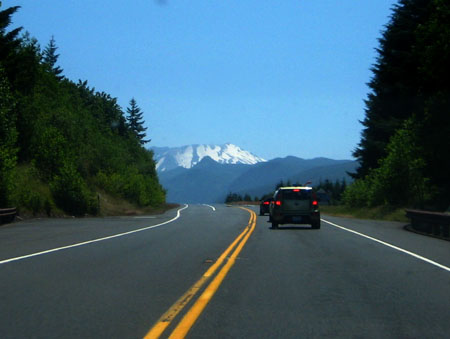
First view of Mt. St. Helens from Route 504.
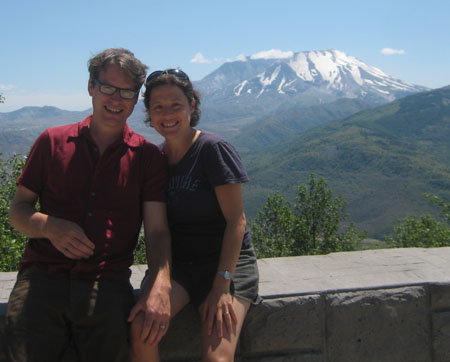
At an overlook along Route 504, photo taken by a stranger.
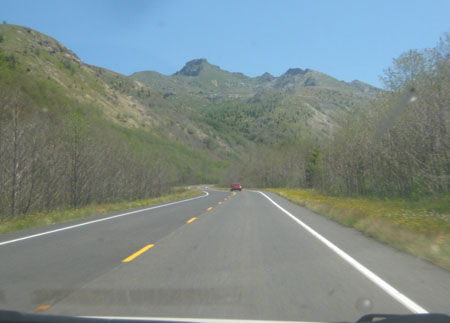
Sheltered from a direct blast from the volcano by a single ridge, the trees in this valley are almost entirely deciduous.
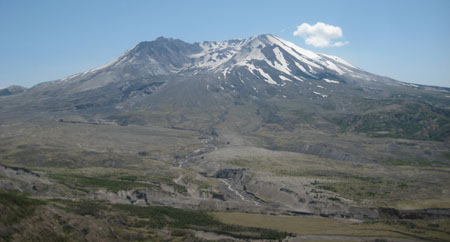
Mt. St. Helens viewed from the north.
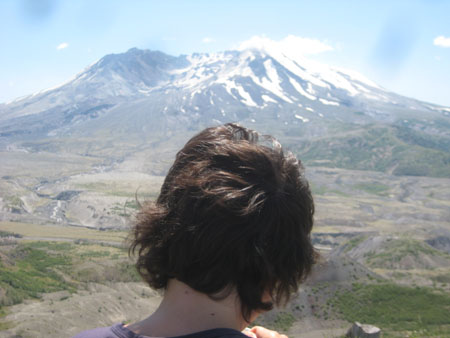
It looks a little like the bottom of Gretchen's haircut in the back.
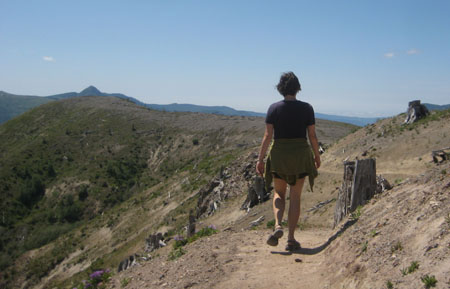
Gretchen in the blast zone landscape.
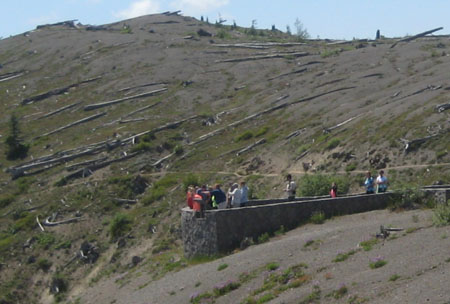
32 year old tree trunks pointing away from the blast zone just below the Johnson Ridge Observatory.
For linking purposes this article's URL is:
http://asecular.com/blog.php?120713 feedback
previous | next |






